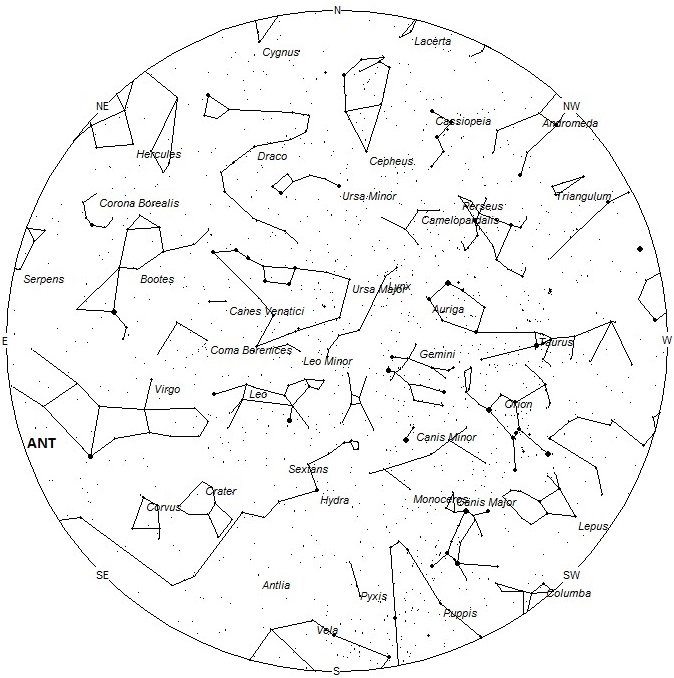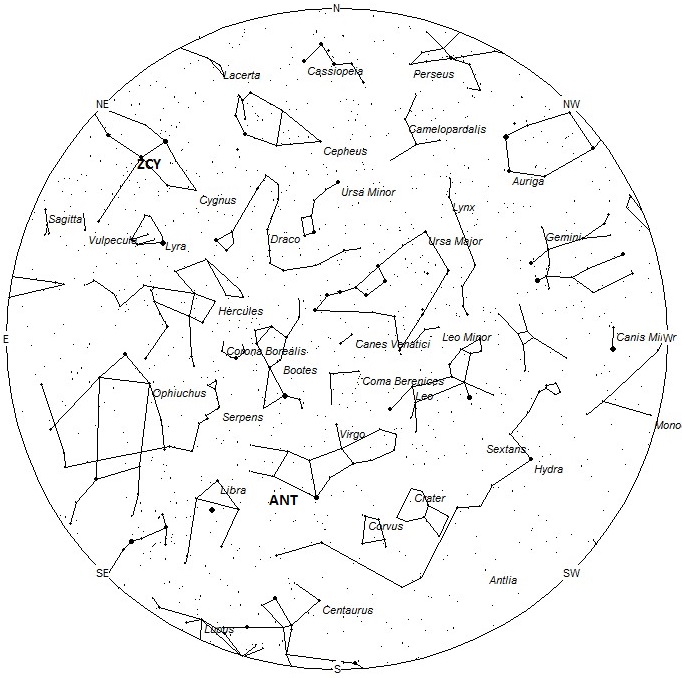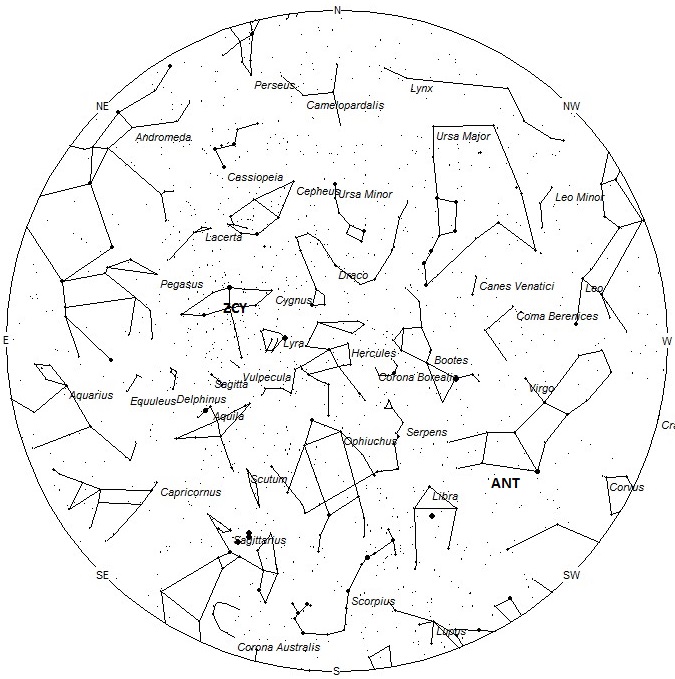
During this period the moon will reach it’s last quarter phase on Sunday April 8. At that time the moon will be located 90 degrees west of the sun and will rise between 02:00 and 3:00 local daylight saving time (LDT) for observers located in mid-northern latitudes. As the week progresses the waning crescent moon will become less of a problem as it rises later each passing night. The estimated total hourly meteor rates for evening observers this week is 3 as seen from mid-northern latitude (45N) and 4 from the southern tropics (25S). For morning observers the estimated total hourly rates should be near 6 as seen from mid-northern latitudes (45N) and 9 from the southern tropics (25S). The actual rates will also depend on factors such as personal light and motion perception, local weather conditions, alertness and experience in watching meteor activity. Morning rates are reduced during this period due to interfering moonlight. Note that the hourly rates listed below are estimates as viewed from dark sky sites away from urban light sources. Observers viewing from urban areas will see less activity as only the brighter meteors will be visible from such locations.
The radiant (the area of the sky where meteors appear to shoot from) positions and rates listed below are exact for Saturday night/Sunday morning April 7/8. These positions do not change greatly day to day so the listed coordinates may be used during this entire period. Most star atlases (available at science stores and planetariums) will provide maps with grid lines of the celestial coordinates so that you may find out exactly where these positions are located in the sky. A planisphere or computer planetarium program is also useful in showing the sky at any time of night on any date of the year. Activity from each radiant is best seen when it is positioned highest in the sky, either due north or south along the meridian, depending on your latitude. It must be remembered that meteor activity is rarely seen at the radiant position. Rather they shoot outwards from the radiant so it is best to center your field of view so that the radiant lies near the edge and not the center. Viewing there will allow you to easily trace the path of each meteor back to the radiant (if it is a shower member) or in another direction if it is a sporadic. Meteor activity is not seen from radiants that are located far below the horizon. The positions below are listed in a west to east manner in order of right ascension (celestial longitude). The positions listed first are located further west therefore are accessible earlier in the night while those listed further down the list rise later in the night.
These sources of meteoric activity are expected to be active this week.
.
The center of the large Anthelion (ANT) radiant is currently located at 14:04 (211) -13. This position lies in southeastern Virgo, 3 degrees southwest of the faint star known as Kang (kappa Virginis). Due to the large size of this radiant, Anthelion activity may also appear from western Libra as well as Virgo. This radiant is best placed near 0200 LDT, when it lies on the meridian and is located highest in the sky. Rates at this time should be near 2 per hour no matter your location. With an entry velocity of 30 km/sec., the average Anthelion meteor would be of slow velocity.
The last of the zeta Cygnids (ZCY) should be seen through April 10th The expected radiant lies near 20:12 (303) +41. This position is located in central Cygnus, 3 degrees northwest of the 2th magnitude star known as Sadr (gamma Cygni). This radiant is best placed during the last hour before dawn when it lies highest above the horizon in a dark sky. Rates are expected to be less than 1 per hour no matter your location . With an entry velocity of 40 km/sec., the average meteor from this source would be of medium velocity.
As seen from the mid-northern hemisphere (45N) one would expect to see approximately 4 sporadic meteors per hour during the last hour before dawn as seen from rural observing sites. Evening rates would be near 2 per hour. As seen from the tropical southern latitudes (25S), morning rates would be near 7 per hour as seen from rural observing sites and 3 per hour during the evening hours. Locations between these two extremes would see activity between the listed figures. Morning rates are slightly reduced due to moonlight.
| SHOWER | DATE OF MAXIMUM ACTIVITY | CELESTIAL POSITION | ENTRY VELOCITY | CULMINATION | HOURLY RATE | CLASS |
| RA (RA in Deg.) DEC | Km/Sec | Local Daylight Saving Time | North-South | |||
| Anthelion (ANT) | – | 14:04 (211) -13 | 30 | 02:00 | 2 – 2 | II |
| zeta Cygnids (ZCY) | Apr 06 | 20:12 (303) +41 | 40 | 08:00 | <1 – <1 | IV |
 American Meteor Society
American Meteor Society



Good evening Mr. Lunsford, last night around 2:30-3 am. I live about 50-55 miles south of Corpus Christi Tx. Rural community with lots of open spaces. Not really sure of the angle in degrees. But, my best would have to West at my 4 o’clock, hubby was in the Armed Forces and I’m a elementary school teacher. I noticed the night very clear, and full of dancing stars. Then I look west and there it was, the tail. In close proximity to moon, which shined very bright. I was able to see the color of it’s tail. This is typical of a “shooting star”. Now here is when I thought it got interesting, the it’s tail was like a corkscrew. Then, s it started to level with the Moon it seemed to disappear. But you could still see the corkscrew pattern it create in the color gray and no telescope needed. (clear as day). I know sometimes they can and do create noises, hence I was outside wondering why my neighbors dog was BARKING that this ungodly hour. If you just happen to have a picture of. I know my students would absolutely love to see. (trying to inspire a generation Aim for the Stars!
Thank you.
hey just saw one right over my house. it was super bright actually and seemed pretty low. Broke apart and sort of looked like welding sparks. super pumped, love seeing them. makes me feel like a little boy all over again every time, full of wonder.
Love AMSO